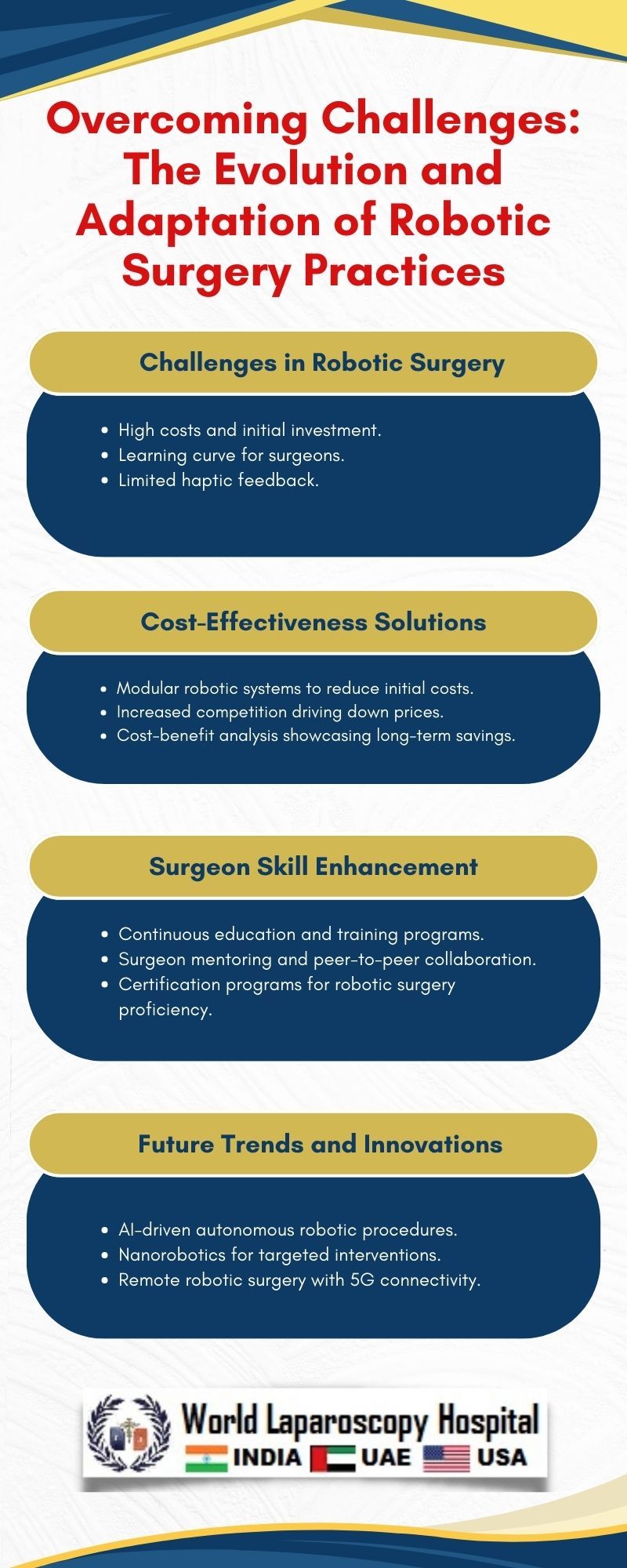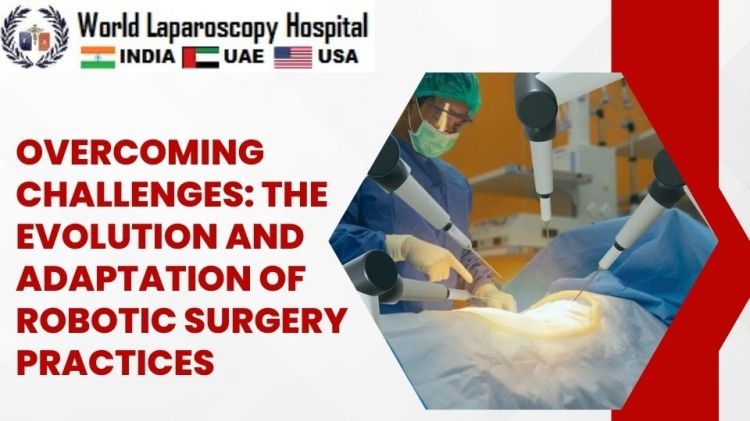Overcoming Challenges: The Evolution and Adaptation of Robotic Surgery Practices
Introduction
The field of robotic surgery has experienced remarkable growth and transformation over the years, pushing the boundaries of medical innovation. As technology continues to evolve, so do the challenges faced by surgeons and developers in the realm of robotic surgical practices. This article explores the journey of robotic surgery, highlighting the challenges encountered and the innovative solutions that have emerged, contributing to the evolution and adaptation of this cutting-edge medical technique.

The Genesis of Robotic Surgery
Robotic surgery had its humble beginnings in the late 20th century, with the da Vinci Surgical System marking a milestone in 1999. Initially designed for military purposes, the da Vinci system rapidly found its place in the medical field. However, the early stages of robotic surgery were not without hurdles.
Challenges in Early Adoption
The primary challenges during the early adoption of robotic surgery were centered around technology limitations, surgeon training, and cost. The robotic systems were bulky, with limited dexterity and range of motion compared to the human hand. Surgeons faced a steep learning curve in mastering the robotic interfaces, leading to longer operating times and increased risks.
Overcoming Technical Limitations
As technology advanced, so did the capabilities of robotic surgical systems. Engineers and developers worked relentlessly to enhance the robotic arms' precision, incorporating more degrees of freedom and miniaturizing instruments. This evolution addressed the technical limitations, allowing surgeons greater control and maneuverability during procedures.
Improved Visualization and Instrumentation
One of the critical aspects of robotic surgery is visualization. Overcoming challenges related to limited visibility in early systems, modern robotic platforms now offer high-definition 3D imaging and advanced lighting systems. These improvements contribute to better navigation within the surgical site, enabling surgeons to perform intricate procedures with greater accuracy.
Enhanced Haptic Feedback
Early robotic systems lacked adequate haptic feedback, making it challenging for surgeons to perceive the sense of touch. Addressing this limitation, contemporary robotic platforms are equipped with advanced haptic technology, providing surgeons with tactile feedback. This enhancement allows for a more immersive and precise surgical experience, closely mimicking traditional open surgery.
Surgeon Training and Skill Development
The initial hurdle of surgeon training has been a persistent challenge in the evolution of robotic surgery. Overcoming this required the development of comprehensive training programs and simulators. Today, surgeons undergo specialized training to familiarize themselves with robotic interfaces, allowing them to transition seamlessly from traditional to robotic techniques.
Simulated Environments and Virtual Reality
Simulation and virtual reality have played pivotal roles in overcoming training challenges. Surgeons can now practice and refine their skills in realistic virtual environments before performing actual surgeries. This not only accelerates the learning process but also ensures a higher level of competence and confidence among surgeons adopting robotic techniques.
Cost and Accessibility
The high cost of robotic systems posed a significant barrier to widespread adoption in the early days. However, as demand increased and technology matured, costs began to decrease. Moreover, advancements in manufacturing and competition among robotic surgery system developers have contributed to making these technologies more accessible to healthcare institutions.
Evolving Surgical Applications
The evolution of robotic surgery is not limited to addressing technical challenges alone. The scope of applications has expanded significantly, encompassing various medical specialties. Initially employed in urology and gynecology, robotic surgery is now utilized in areas such as cardiovascular surgery, orthopedics, and even head and neck surgery.
Urology and Gynecology: Pioneering Applications
Urology and gynecology were among the first medical specialties to embrace robotic surgery. The minimally invasive nature of robotic procedures proved advantageous in surgeries such as prostatectomies and hysterectomies. The precision and reduced recovery times associated with robotic techniques contributed to their rapid adoption in these fields.
Cardiovascular Surgery: Navigating Complex Terrains
The intricate nature of cardiovascular surgery posed unique challenges for robotic applications. Overcoming these challenges required advancements in technology to accommodate the delicacy and precision required for procedures such as coronary artery bypass surgery. Today, robotic systems are increasingly employed in cardiovascular interventions, enhancing the capabilities of surgeons in this critical domain.
Orthopedics: Precision in Joint Surgeries
Orthopedic surgeries, particularly joint replacement procedures, have witnessed a paradigm shift with the introduction of robotic assistance. The ability of robotic systems to assist in precise bone resections and implant placement has led to improved outcomes and reduced postoperative complications. This evolution in orthopedic surgery demonstrates the adaptability of robotic systems across diverse medical fields.
Neurosurgery: Navigating the Intricate Landscape
Navigating the complexities of the human brain and spinal cord presents unique challenges in neurosurgery. Robotic surgery has made significant strides in this domain, enabling surgeons to perform intricate procedures with enhanced precision. From tumor removals to deep brain stimulation, robotic assistance has expanded the possibilities in neurosurgical interventions.
Challenges in Autonomous Robotic Surgery
The future of robotic surgery holds the promise of autonomy, with the development of robotic systems capable of performing certain procedures independently. However, this transition towards autonomous surgery brings forth a new set of challenges, including ethical considerations, legal implications, and the need for fail-safe mechanisms.
Ethical Considerations and Patient Safety
The prospect of autonomous robotic surgery raises ethical questions regarding patient safety and decision-making. Ensuring that robotic systems operate within defined parameters and prioritize patient well-being is crucial. Striking a balance between the benefits of autonomy and the ethical considerations surrounding patient care remains a challenge in the ongoing evolution of robotic surgery.
Legal and Regulatory Frameworks
The introduction of autonomous robotic systems necessitates the establishment of clear legal and regulatory frameworks. Determining liability in the event of errors or complications during autonomous procedures is a complex issue that requires careful consideration. As technology advances, policymakers and regulatory bodies must adapt to ensure the safe and responsible integration of autonomous robotic surgery into healthcare practices.
Fail-Safe Mechanisms and Redundancies
To address concerns related to the reliability of autonomous robotic systems, the development of fail-safe mechanisms and redundancies is essential. Implementing safeguards that allow human intervention in case of unforeseen circumstances is crucial to building trust in autonomous robotic surgery. Engineers and healthcare professionals are collaboratively working on creating fail-safe protocols to mitigate potential risks.
Human-Machine Collaboration
An alternative approach to full autonomy is human-machine collaboration, where robotic systems work in tandem with human surgeons. This synergistic partnership combines the precision and efficiency of robotic technology with the nuanced decision-making and adaptability of human surgeons. Striking the right balance in this collaboration remains a challenge, requiring seamless integration and effective communication between humans and machines.
Conclusion
The evolution and adaptation of robotic surgery practices have been a testament to the relentless pursuit of innovation and the collaboration between surgeons, engineers, and healthcare professionals. From overcoming technical limitations to expanding the scope of applications across medical specialties, robotic surgery has come a long way.
As the field progresses towards autonomous surgery, it faces new challenges that extend beyond technological considerations. Ethical, legal, and safety concerns necessitate careful deliberation and the establishment of robust frameworks. Human-machine collaboration emerges as a promising path, offering the potential to harness the benefits of robotic technology while preserving the essential elements of human decision-making and oversight.






